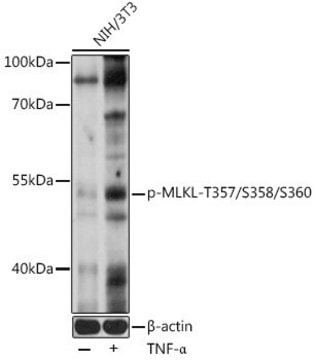AB5566
Anti-Capsaicin Receptor Antibody, CT
serum, Chemicon®
Synonym(s):
Vanilloid Receptor 1, VR1
Sign Into View Organizational & Contract Pricing
All Photos(1)
About This Item
UNSPSC Code:
12352203
eCl@ss:
32160702
NACRES:
NA.41
Recommended Products
biological source
guinea pig
Quality Level
antibody form
serum
antibody product type
primary antibodies
clone
polyclonal
species reactivity
rat
manufacturer/tradename
Chemicon®
technique(s)
immunohistochemistry: suitable
NCBI accession no.
UniProt accession no.
shipped in
dry ice
target post-translational modification
unmodified
Gene Information
human ... TRPV1(7442)
Specificity
Recognizes Capsaicin Receptor (Vanilloid Receptor 1, VR1).
Immunogen
A 22 amino acid peptide corresponding to the C-terminus of the rat Capsaicin Receptor protein (Catalog number AG298).
Application
Anti-Capsaicin Receptor Antibody, C-terminus detects level of Capsaicin Receptor & has been published & validated for use in IH.
Immunohistochemistry: 1:1,000. The antibody reacts well with tissue from the rat dorsal root ganglia.
Optimal working dilutions must be determined by end user.
Optimal working dilutions must be determined by end user.
Physical form
Serum. Liquid. Contains less than 0.02% sodium azide.
Analysis Note
Control
Immunogen peptide (catalog number AG298) is available for preadsorbtion control studies.
Immunogen peptide (catalog number AG298) is available for preadsorbtion control studies.
Other Notes
Concentration: Please refer to the Certificate of Analysis for the lot-specific concentration.
Legal Information
CHEMICON is a registered trademark of Merck KGaA, Darmstadt, Germany
Not finding the right product?
Try our Product Selector Tool.
Storage Class Code
10 - Combustible liquids
WGK
WGK 1
Certificates of Analysis (COA)
Search for Certificates of Analysis (COA) by entering the products Lot/Batch Number. Lot and Batch Numbers can be found on a product’s label following the words ‘Lot’ or ‘Batch’.
Already Own This Product?
Find documentation for the products that you have recently purchased in the Document Library.
S-Q He et al.
Neuroscience, 261, 43-51 (2014-01-01)
Mas-related G-protein-coupled receptor subtype C (MrgC) may play an important role in pain sensation. However, the distribution of MrgC receptors in different subpopulations of rodent dorsal root ganglion (DRG) neurons has not been clearly demonstrated owing to a lack of
Yumi Matsushita et al.
The Journal of veterinary medical science, 83(10), 1570-1581 (2021-09-03)
The activation of α2 adrenergic receptors contributes to analgesia not only in the central nervous system but also in the peripheral nervous system. We reported that noradrenaline inhibits the activity of transient receptor potential vanilloid 1 (TRPV1) evoked by capsaicin
Transient receptor potential vanilloid type 1 channel (TRPV1) immunolocalization in the murine enteric nervous system is affected by the targeted C-terminal epitope of the applied antibody.
Buckinx, R; Van Nassauw, L; Avula, LR; Alpaerts, K; Adriaensen, D; Timmermans, JP
The journal of histochemistry and cytochemistry : official journal of the Histochemistry Society null
Sam M Hermes et al.
Journal of chemical neuroanatomy, 72, 1-7 (2015-12-27)
The vagus nerve is dominated by afferent fibers that convey sensory information from the viscera to the brain. Most vagal afferents are unmyelinated, slow-conducting C-fibers, while a smaller portion are myelinated, fast-conducting A-fibers. Vagal afferents terminate in the nucleus tractus
Shuohao Sun et al.
Neuron, 93(4), 840-853 (2017-02-24)
Coding of itch versus pain has been heatedly debated for decades. However, the current coding theories (labeled line, intensity, and selectivity theory) cannot accommodate all experimental observations. Here we identified a subset of spinal interneurons, labeled by gastrin-releasing peptide (Grp)
Our team of scientists has experience in all areas of research including Life Science, Material Science, Chemical Synthesis, Chromatography, Analytical and many others.
Contact Technical Service








